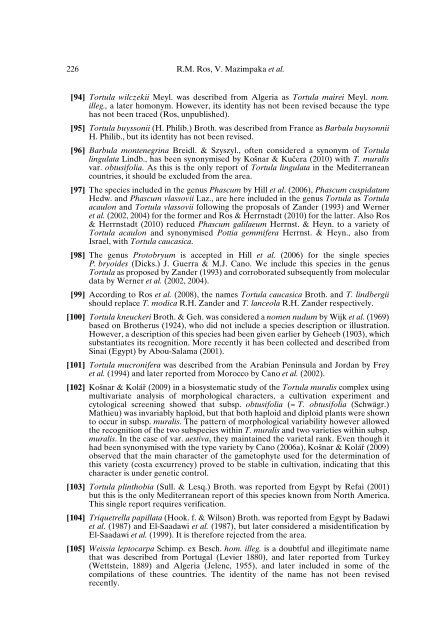Mosses of the Mediterranean, an annotated checklist - Optima-bot.org
Mosses of the Mediterranean, an annotated checklist - Optima-bot.org
Mosses of the Mediterranean, an annotated checklist - Optima-bot.org
You also want an ePaper? Increase the reach of your titles
YUMPU automatically turns print PDFs into web optimized ePapers that Google loves.
226 R.M. Ros, V. Mazimpaka et al.[94] Tortula wilczekii Meyl. was described from Algeria as Tortula mairei Meyl. nom.illeg., a later homonym. However, its identity has not been revised because <strong>the</strong> typehas not been traced (Ros, unpublished).[95] Tortula buyssonii (H. Philib.) Broth. was described from Fr<strong>an</strong>ce as Barbula buysonniiH. Philib., but its identity has not been revised.[96] Barbula montenegrina Breidl. & Szyszyl., <strong>of</strong>ten considered a synonym <strong>of</strong> Tortulalingulata Lindb., has been synonymised by Ko≠nar & Kuªera (2010) with T. muralisvar. obtusifolia. As this is <strong>the</strong> only report <strong>of</strong> Tortula lingulata in <strong>the</strong> <strong>Mediterr<strong>an</strong>e<strong>an</strong></strong>countries, it should be excluded from <strong>the</strong> area.[97] The species included in <strong>the</strong> genus Phascum by Hill et al. (2006), Phascum cuspidatumHedw. <strong>an</strong>d Phascum vlassovii Laz., are here included in <strong>the</strong> genus Tortula as Tortulaacaulon <strong>an</strong>d Tortula vlassovii following <strong>the</strong> proposals <strong>of</strong> Z<strong>an</strong>der (1993) <strong>an</strong>d Werneret al. (2002, 2004) for <strong>the</strong> former <strong>an</strong>d Ros & Herrnstadt (2010) for <strong>the</strong> latter. Also Ros& Herrnstadt (2010) reduced Phascum galilaeum Herrnst. & Heyn. to a variety <strong>of</strong>Tortula acaulon <strong>an</strong>d synonymised Pottia gemmifera Herrnst. & Heyn., also fromIsrael, with Tortula caucasica.[98] The genus Protobryum is accepted in Hill et al. (2006) for <strong>the</strong> single speciesP. bryoides (Dicks.) J. Guerra & M.J. C<strong>an</strong>o. We include this species in <strong>the</strong> genusTortula as proposed by Z<strong>an</strong>der (1993) <strong>an</strong>d corroborated subsequently from moleculardata by Werner et al. (2002, 2004).[99] According to Ros et al. (2008), <strong>the</strong> names Tortula caucasica Broth. <strong>an</strong>d T. lindbergiishould replace T. modica R.H. Z<strong>an</strong>der <strong>an</strong>d T. l<strong>an</strong>ceola R.H. Z<strong>an</strong>der respectively.[100] Tortula kneuckeri Broth. & Geh. was considered a nomen nudum by Wijk et al. (1969)based on Bro<strong>the</strong>rus (1924), who did not include a species description or illustration.However, a description <strong>of</strong> this species had been given earlier by Geheeb (1903), whichsubst<strong>an</strong>tiates its recognition. More recently it has been collected <strong>an</strong>d described fromSinai (Egypt) by Abou-Salama (2001).[101] Tortula mucronifera was described from <strong>the</strong> Arabi<strong>an</strong> Peninsula <strong>an</strong>d Jord<strong>an</strong> by Freyet al. (1994) <strong>an</strong>d later reported from Morocco by C<strong>an</strong>o et al. (2002).[102] Ko≠nar & Kolá÷ (2009) in a biosystematic study <strong>of</strong> <strong>the</strong> Tortula muralis complex usingmultivariate <strong>an</strong>alysis <strong>of</strong> morphological characters, a cultivation experiment <strong>an</strong>dcytological screening showed that subsp. obtusifolia (= T. obtusifolia (Schwägr.)Mathieu) was invariably haploid, but that <strong>bot</strong>h haploid <strong>an</strong>d diploid pl<strong>an</strong>ts were shownto occur in subsp. muralis. The pattern <strong>of</strong> morphological variability however allowed<strong>the</strong> recognition <strong>of</strong> <strong>the</strong> two subspecies within T. muralis <strong>an</strong>d two varieties within subsp.muralis. In <strong>the</strong> case <strong>of</strong> var. aestiva, <strong>the</strong>y maintained <strong>the</strong> varietal r<strong>an</strong>k. Even though ithad been synonymised with <strong>the</strong> type variety by C<strong>an</strong>o (2006a), Ko≠nar & Kolá÷ (2009)observed that <strong>the</strong> main character <strong>of</strong> <strong>the</strong> gametophyte used for <strong>the</strong> determination <strong>of</strong>this variety (costa excurrency) proved to be stable in cultivation, indicating that thischaracter is under genetic control.[103] Tortula plinthobia (Sull. & Lesq.) Broth. was reported from Egypt by Refai (2001)but this is <strong>the</strong> only <strong>Mediterr<strong>an</strong>e<strong>an</strong></strong> report <strong>of</strong> this species known from North America.This single report requires verification.[104] Triquetrella papillata (Hook. f. & Wilson) Broth. was reported from Egypt by Badawiet al. (1987) <strong>an</strong>d El-Saadawi et al. (1987), but later considered a misidentification byEl-Saadawi et al. (1999). It is <strong>the</strong>refore rejected from <strong>the</strong> area.[105] Weissia leptocarpa Schimp. ex Besch. hom. illeg. is a doubtful <strong>an</strong>d illegitimate namethat was described from Portugal (Levier 1880), <strong>an</strong>d later reported from Turkey(Wettstein, 1889) <strong>an</strong>d Algeria (Jelenc, 1955), <strong>an</strong>d later included in some <strong>of</strong> <strong>the</strong>compilations <strong>of</strong> <strong>the</strong>se countries. The identity <strong>of</strong> <strong>the</strong> name has not been revisedrecently.






